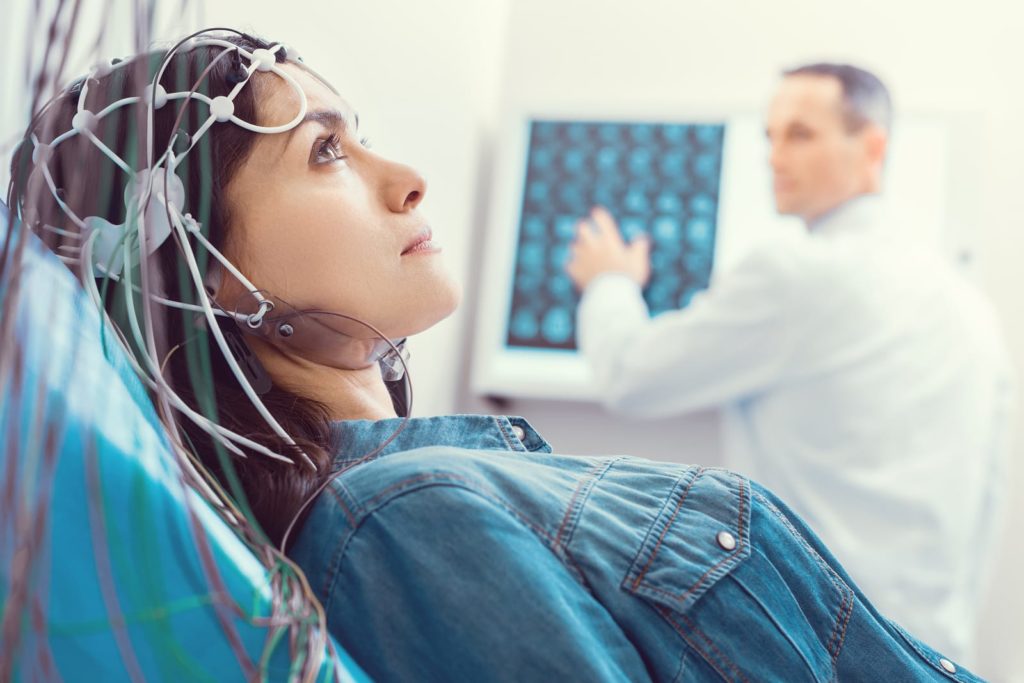Transcranial direct current stimulation (tDCS) is a brain-stimulating technique that uses very low levels of electrical current to change the amount of activity taking place in the brain’s main nerve cells, called neurons. This technique differs from another similarly named form of brain stimulation called transcranial magnetic stimulation (TMS). Current evidence indicates that tDCS can help relieve the symptoms of major depression, even in people who have not responded well to other forms of depression treatment. Use of the technique may also help improve brain function in several other ways.
Transcranial Direct Current Stimulation Basics
During transcranial direct current stimulation, a doctor places two electricity-conducting devices – called electrodes – on opposite sides or ends of a patient’s scalp. After the electrodes are arranged, the doctor activates them with a weak electrical signal. This signal spreads out and passes through large sections of the brain. Unlike the current used in another form of brain stimulation, called electroconvulsive therapy, the current used in tDCS is too weak to directly alter the way the brain’s neurons talk to each other. Instead, it creates subtler changes that indirectly alter neuron communication. Despite the weakness of the electrical current used during tDCS, the technique can produce significant changes in parts of the brain responsible for mood control when it’s used regularly over a period of days or weeks. Mental health experts are interested in transcranial direct current stimulation because it doesn’t cost a lot of money to perform, doesn’t produce serious or lasting side effects, and doesn’t disturb the body as much as other brain-stimulating approaches such as electroconvulsive therapy or vagus nerve stimulation. Still, the technique has not yet received official sanction from the Food and Drug Administration.
Effectiveness of Treatment
In a study published in 2012 in the British Journal of Psychiatry, a team of New Zealand researchers used transcranial direct current stimulation on a group of major depression patients who still had significant symptoms after trying at least two other forms of depression treatment. Each of the study participants received tDCS for 20 minutes a day over a period of several weeks. After three weeks of treatment, roughly 13 percent of the participants saw a substantial decline in their depression symptoms; however, after an additional three weeks of treatment, close to 50 percent of the study participants experienced symptom improvement. After receiving periodic follow-up treatments, roughly 85 of the people who initially responded well to tDCS continued to experience benefits three months later. In another study, published in 2013 in the American Medical Association’s JAMA Psychiatry, a team of Brazilian researchers compared the effectiveness of transcranial direct current stimulation to the effectiveness of a widely used antidepressant medication called sertraline (Zoloft). These researchers concluded that people who receive tDCS experience just as much symptom relief as people who use Zoloft. They also concluded that people who receive both tDCS and Zoloft see a greater improvement in their depression symptoms than people who receive just tDCS or just Zoloft. In addition, they determined that tDCS is equally as safe as Zoloft.
Treatment Considerations
Relatively common potential side effects of transcranial direct current stimulation include redness at the site of treatment and tingling or itching at the site of treatment. Less common potential effects include burning at the site of treatment, dizziness, headaches, and unusual fatigue. Relatively rare potential side effects include such things as pain at the treatment site, blurry vision, nausea, watery eyes, a temporary loss of mental focus, neck soreness, unusual changes in the visual field, skin flaking, giddiness, and trembling or shaking. The authors of the study in the British Journal of Psychiatry report that none of these side effects are severe or long-lasting. However, one study participant developed a relatively mild form of mania called hypomania and didn’t complete tDCS treatment. A number of studies indicate that transcranial direct current stimulation can produce other beneficial changes in brain function, including such things as a decreased sensitivity to pain and improved ability to use memory, plan for the future, and use language effectively. The authors of a study review published in 2012 in the journal Expert Review of Neurotherapeutics believe that these other benefits may be the result of the widespread electrical field produced by tDCS, which has an effect on multiple brain areas during treatment.

